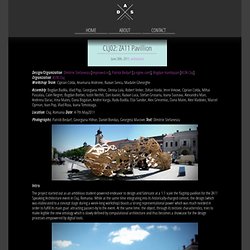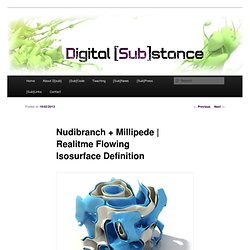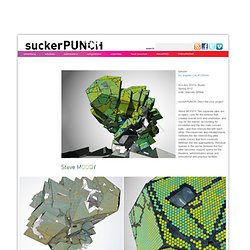

Blog Archive » Rhino Explicit History. A new plug-in for Rhino4 is being developed.

Rhino is finally going (pseudo) parametric. It’s still at an early stage, but the potential it has is amazing. I’ve been exploring this new world of Rhino past few days. It’s like scripting without coding. Here’s an example of what it can do. Ana-maria ANTON architecture PORTFOLIO.
LightForm – PROJECTiONE. Now for sale are our LightForm mylar luminaires!

The system was developed by PROJECTiONE over the last couple of years and is now in full production. Each lamp is crafted utilizing parametric digital software, CNC hardware, and hand assembly. We developed a definition in Grasshopper, a plugin for Rhinoceros, that can produce all the cut files necessary to create each lamp by only using one input, the lamp’s desired profile curve. This allows us to produce a large number of shapes and sizes from the same joinery system, which reduces the cost of custom and increases design possibilities. Sk_mesh01. @improved. CLJ02: ZA11 Pavillion – @improved. Design/Organization: Dimitrie Stefanescu [improved.ro], Patrick Bedarf [a-ngine.com], Bogdan Hambasan [ASTA Cluj]Organization: ASTA ClujWorkshop Team: Ciprian Colda, Anamaria Androne, Razvan Sencu, Madalin Gheorghe Assembly: Bogdan Badila, Vlad Pop, Georgiana Hlihor, Denisa Lula, Robert Veber, Zoltan Vaida, Imre Vekove, Ciprian Colda, Mihai Pascalau, Calin Negret, Bogdan Borbei, Iustin Nechiti, Dan Ioanici, Razvan Luca, Stefan Grosariu, Ioana Suceava, Alexandra Man, Andreea Darac, Irina Mates, Oana Bogatan, Andrei Varga, Radu Badila, Elza Sandor, Alex Greceniuc, Oana Matei, Alex Vladovici, Marcel Oprean, Ioan Pop, Vlad Rusu, Ioana Tomoioaga.

Location: Cluj, Romania Date: 4-7th May2011. LIVE COMPONENTS. Fibrous behaviour by Jonas Sin. ‘Fibrous structure’ inherits the properties of fluidity and flexibility to generate multi-directional circulations manifested in a hyperlinked system.

Fibrous Structures aimed to explore the potential for design innovationusing parametric modeling tools and fiber-reinforced super-fluid concretes, which is developed from line- to surface technique, which line could mesh together into surfaces to create a porous system (‘nets’) where holesare co-evolve with the geometry. The most important conceptual gesture is the one ofconvergence, the design has distinguishable programme, but as a whole it does not have discretely differentparts. Synthetic Grain Prototype – PROJECTiONE. The concept for the piece looks at combining natural and synthetic materials in an interesting way.

The primary material is one we are familiar with, white HIPS. Our idea was to develop a contoured wall surface that wasn’t constrained by the typical techniques of contouring (create a surface, chop it into 2d strips, and reassemble). By using a flexible material we were able to cut out each custom profile while also letting each strip uniquely bend in elevation. This creates a much more dynamic result and really plays with perception. Form was driven by a series of weighted attractor points that manipulate curves rather than an input surface.
Look for a full scale project to come in the near future! Folding Patterns. HYPERLAXITY – PROJECTiONE. Realitme Flowing Isosurface Definition. I know I haven’t properly updated the Nudibranch examples on the GH forum, however since I have been getting a lot of requests to display what and how exactly this isosurface snapshot from the previous post about the release of Nudibranch works, i decided to spent a few hours to document this process and also share the definition.

Take a look at the following video. This definition uses two Nudibranch components the Satellites and the AttractorValues, combined with the Millipede’s isosurface component. Three or more satellite entities create a 3d non-uniformal field of values from 0.00 to 0.5 these values are fed to the isosurface component and Voila!!. No hustle animated complexity defined by certain rules ( number of attractors, equation for the values distribution <cos,sinc ect>. You can download the definition as usual from the [Sub]code page. Sk_mesh01. Fibre Composite Adaptive Systems. Designed by Maria Mingallon, Sakthivel Ramaswamy, Konstantinos Karatzas Fibre composite adaptive systems is a research project which emulates self-organisation processes in nature by developing a fibre composite that can sense, actuate and hence efficiently adapt to changing environmental conditions.

Fibre composites which are anisotropic and heterogeneous offer the possibility for local variations in their material properties. Embedded fibre optics would be used to sense multiple parameters and shape memory alloys integrated in a fibre composite material for actuation. The definition of the geometry, both locally and globally would complement the adaptive functions and hence the system would display ’Integrated Functionality’.
‘Thigmo-morphogenesis’ refers to the changes in shape, structure and material properties of biological organisms that are produced in response to transient changes in environmental conditions. Geode. Los angeles CALIFORNIA SCI-Arc, ESTm Studio Spring 2012 critic: Marcelo SPINA suckerPUNCH: Describe your project.

Steve MOODY: Two separate piles are scripted—one for the exterior that creates overall form and orientation, and one for the interior, accounting for circulation and the two main concert halls—and then intersected with each other. Discrepancies and misalignments between the two intersecting piles create cracks that form continuity between the two aggregations. Residual spaces in the poche between the two piles becomes support space for the theaters, administrative areas and educational and practice facilities. The exterior is tiled in with a pattern and colors derived from the processes of intersection and overlapping, creating another layer of continuity (and discontinuity) across the fractured form. sP: What or who influenced this project?